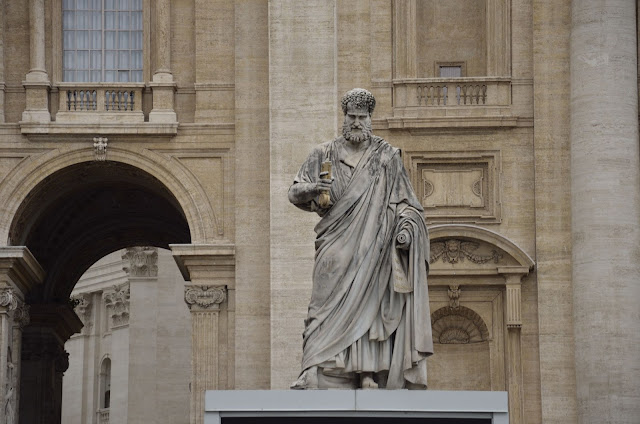Visiting Santorini,
Greece has been
a dream of mine for a long time. I’ve
seen all those gorgeous photos of the white buildings with their blue-domed
roofs. And the water, it’s the bluest of
anyplace I’ve ever seen – in the photos, that is. The fact that this was a port on this itinerary had a lot to do with our decision to book this cruise.
It’s a tender port because there is no pier. The ship dropped anchor out in the harbor and
tender boats were used to take 200 people to shore at a time. So my first glimpse of it (because we have an
inside cabin with no window or door) was from the elevator as we went to
breakfast. Now granted, the windows were dirty, my eyes were still a little blurry, and we do live in Denver where snow-capped
mountains are our norm – but my first thought was “is that SNOW on the mountain
top”? I blinked my eyes to try to clear
them. No – those are houses up there! This is the way I saw it…
And this is zoomed in…
Seriously! Santorini
wasn’t at all what I expected. The west
side of the island is bluffs as high as 980 feet straight up. The buildings all sit at the top, and the
rest is just layers of lava and pumice with little vegetation. It’s really not that pretty, and not at ALL
like the photos. But the water, oh my,
it’s so blue and beautiful. That part is
as advertised.
There are a few sea-level docks where the small boats can
come in to. Then you must walk up (yikes!), take the cable
car, ride the donkeys, or drive on switch-back roads to reach
the top.
Our tour began with a short boat ride to a small fishing
village on the south end of the island.
From there, we boarded a bus which took us up the switch-back road to
the top. The views are absolutely
breath-taking. The higher you go, the
more beautiful the water becomes. We
were so blessed with a warm, sunny day without much wind.
We drove through a small village which was the home of our
guide, Harra. She explained that all the
churches are privately owned by families, and in her town of 600 people there are
over 65 churches. Santorini has a
population of 15,000 people spread across 13 small villages, and there are over
400 churches and 1,000 hotels.
Our first stop was the Santo Winery. They gave us a short talk about how they make
wine on the island. There is little rain
and no fresh water on Santorini. All of their drinking water comes from desalinization of sea water. They practice dry agriculture, nothing can be irrigated. It is so
humid that the nutrient rich and very porous lava and pumice readily absorb and
retain moisture, just enough for crops to prosper. Forty varieties of grapes are grown to
support the island's wine making industry, but arbors and trellises are not
used to support the plants. It is so
windy that the vines are coiled in circles close to the ground to prevent
damage. The wines are very dry with a hint of a salty taste.
They offered a tasting of 3 of their wines, and had a spread
of olives, tomatoes, bread, and goat cheese to go with it. The view from their terrace was
incredible. Saint Irene (Santorini in
Greek) is the result of one of the largest volcanic explosions in history -- the Minoean Eruption 3600 years ago. It is what remains of the Eastern edge of a huge caldera that is filled with water and has 2 other
islands within its crater. Except for
one large limestone outcropping at the top, the entire island is of volcanic
origin with a thick upper crust of hardened white ash (pumice) that was
deposited during the eruption. The other
islands and the ship were visible from the winery.
After some free time here to explore and “make photos”, as
they say here, we then drove along the east side of the island where it flattens
out and there are some black and red sand beaches. The hillside is terraced to prevent erosion
and assist with crop production.
Harra explained that a major earthquake in 1956 destroyed
almost all of the buildings on the island.
When they rebuilt, they used whitewashed concrete instead of stone, and
no dwelling can have more than 2 stories.
Most of the buildings are new (since 1980). There's a law that construction can only take
place during the winter so as not to cause noise during the wine making and tourist
season. It also provides jobs for those
who perform seasonal summer work. There
is no unemployment.
We came into the capital city of Fira for our final stop. We were instructed how to get to the cable
car and given a ticket (it costs 4 EU each way, per person), and then we were
turned loose to shop and explore on our own.
I didn’t like it very much, but it was the best of the 3
alternatives. I hear the donkeys smell
terrible and aren’t very cooperative.
Sometimes they stop and refuse to continue, and you end up leading them
down. The walk is long and
strenuous. Most people take the cable
car.
We waited another 20 minutes to board our tender boat for
the ship. My advice to anyone cruising
here is to be sure you allow plenty of time to get back to the ship from
Fira. You don’t want to wait until the
last tender and then not get on, you’d be waving good-bye to everyone as they
sail away.
Aside from being shocked by the topography, Santorini is
beautiful and I’d definitely return here.
Stay tuned…

























































